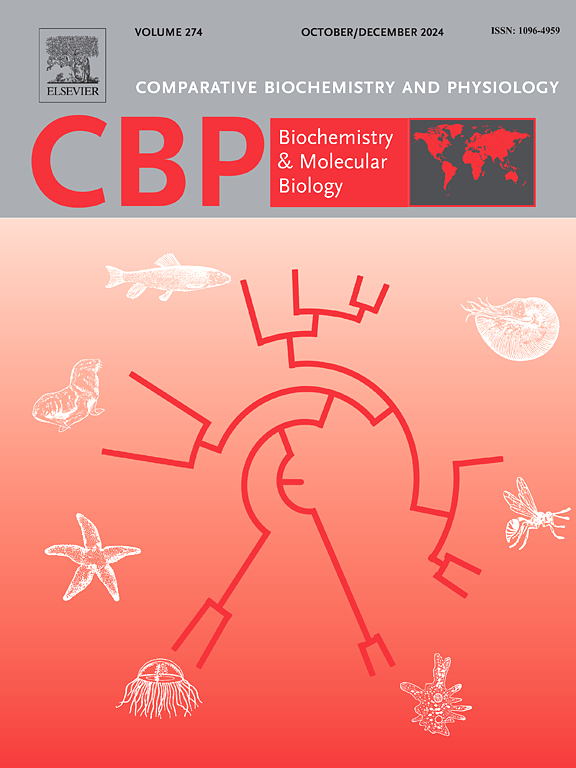Modifications to skeletal muscle morphology correlate with increased thermogenic capacity during cold-acclimation in Dark-eyed Juncos (Junco hyemalis)
IF 1.8
3区 生物学
Q4 BIOCHEMISTRY & MOLECULAR BIOLOGY
Comparative Biochemistry and Physiology B-Biochemistry & Molecular Biology
Pub Date : 2025-06-04
DOI:10.1016/j.cbpb.2025.111114
引用次数: 0
Abstract
Many small endotherms increase their capacity to produce heat in response to cold temperatures. This organismal response is underlain by modifications to lower levels of biological organization. Here we investigated potential changes to muscle morphology in cold-acclimated Dark-eyed Juncos (Junco hyemalis), a widespread North American sparrow. We quantified pectoralis fiber density, fiber cross-sectional area, capillary density, capillary-to-fiber ratio, and fiber type for individuals exposed to cold (−8 °C) or control (18 °C) temperature treatments lasting one to six weeks in duration. We then related pectoralis morphological traits to metabolic traits for these same individuals. We show that pectoralis fiber density quickly increased in the cold, and positively correlated with summit metabolic rate (a proxy for maximal thermogenic capacity) and resting metabolic rate (an index of maintenance cost) in the cold. Fiber density was not, however, related to the duration of the treatment. Moreover, juncos did not exhibit changes in capillarity or fiber type. Our results suggest one physiological avenue by which songbirds may rapidly alter organismal performance in response to variation in ambient temperature.

在冷驯化过程中,骨骼肌形态的改变与黑眼Juncos (Junco hyemalis)产热能力的增加有关。
许多小型恒温动物为了应对寒冷的温度,增加了它们产生热量的能力。这种有机体反应的基础是对较低水平生物组织的修改。在这里,我们研究了一种广泛分布的北美麻雀,适应寒冷的黑眼雀(Junco hyemalis)肌肉形态的潜在变化。我们量化了暴露在持续一到六周的低温(-8 °C)或对照(18 °C)温度处理下的个体的胸肌纤维密度、纤维横截面积、毛细血管密度、毛细血管与纤维的比率和纤维类型。然后,我们将这些个体的胸肌形态特征与代谢特征联系起来。研究表明,胸肌纤维密度在寒冷条件下迅速增加,并与高峰代谢率(最大产热能力的代表)和静息代谢率(维持成本的指标)呈正相关。然而,纤维密度与治疗时间无关。此外,juncos在毛细性和纤维类型上没有表现出变化。我们的研究结果表明,鸣禽可能通过生理途径迅速改变机体性能,以响应环境温度的变化。
本文章由计算机程序翻译,如有差异,请以英文原文为准。
求助全文
约1分钟内获得全文
求助全文
来源期刊
CiteScore
4.60
自引率
4.50%
发文量
77
审稿时长
22 days
期刊介绍:
Comparative Biochemistry & Physiology (CBP) publishes papers in comparative, environmental and evolutionary physiology.
Part B: Biochemical and Molecular Biology (CBPB), focuses on biochemical physiology, primarily bioenergetics/energy metabolism, cell biology, cellular stress responses, enzymology, intermediary metabolism, macromolecular structure and function, gene regulation, evolutionary genetics. Most studies focus on biochemical or molecular analyses that have clear ramifications for physiological processes.

 求助内容:
求助内容: 应助结果提醒方式:
应助结果提醒方式:


